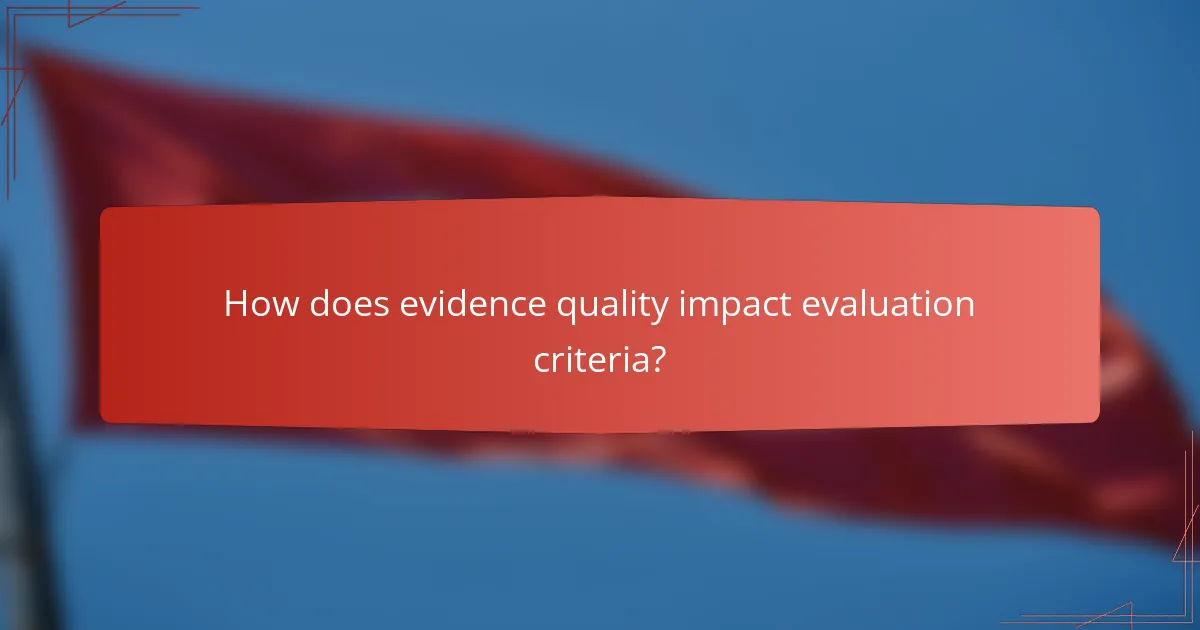Evidence quality plays a crucial role in shaping evaluation criteria, as it directly impacts the validity and reliability of research findings. High-quality evidence supports strong conclusions, while low-quality evidence can lead to misguided decisions. By assessing factors such as relevance, methodological rigor, and transparency, stakeholders can better determine the trustworthiness of the evidence and its applicability to specific research questions.

How does evidence quality impact evaluation criteria?
Evidence quality significantly influences evaluation criteria by determining the validity and reliability of the findings. High-quality evidence leads to more robust conclusions, while poor-quality evidence can misguide decision-making and undermine the evaluation process.
Influences decision-making processes
High-quality evidence is crucial for informed decision-making. When evaluators rely on strong, credible data, they can make choices that are more likely to yield positive outcomes. Conversely, decisions based on weak evidence may lead to ineffective strategies and wasted resources.
For example, in healthcare, treatment options supported by rigorous clinical trials are preferred over those based on anecdotal reports. This reliance on quality evidence ensures that patient care is based on proven effectiveness, ultimately improving health outcomes.
Affects reliability of conclusions
The reliability of conclusions drawn from an evaluation is directly tied to the quality of the evidence. Strong evidence provides a solid foundation for conclusions, while weak evidence can introduce biases and uncertainties. Evaluators must critically assess the sources and methods used to gather evidence to ensure reliability.
Using standardized assessment tools, such as systematic reviews or meta-analyses, can enhance the reliability of conclusions. These methods aggregate high-quality studies, reducing the impact of individual biases and increasing confidence in the overall findings.
Shapes research methodologies
Evidence quality shapes the methodologies researchers choose to employ. High-quality evidence often stems from rigorous methods such as randomized controlled trials or longitudinal studies, which are designed to minimize bias and maximize validity. Researchers must select methodologies that align with the quality of evidence they aim to produce.
For instance, if preliminary data suggests a strong correlation, researchers may opt for a more complex experimental design to further explore causation. This adaptability ensures that the research remains relevant and credible, ultimately enhancing the evaluation process.

What are the key factors in assessing evidence quality?
Assessing evidence quality involves evaluating its relevance, methodological rigor, and transparency. These factors help determine how trustworthy and applicable the evidence is to the research question at hand.
Relevance to the research question
Relevance refers to how closely the evidence addresses the specific research question. Evidence must align with the objectives and context of the study to be considered useful.
When assessing relevance, consider whether the evidence directly supports the hypothesis or provides insights that can lead to conclusions. For example, in medical research, studies focusing on the same condition or treatment type are more relevant than those on unrelated topics.
Methodological rigor
Methodological rigor involves the soundness of the study design and execution. High-quality evidence typically comes from studies that use robust methods, such as randomized controlled trials or systematic reviews.
Key aspects to evaluate include sample size, control groups, and statistical analysis. A well-designed study will minimize bias and confounding factors, enhancing the reliability of its findings. For instance, a clinical trial with a large sample size and proper randomization is generally more credible than one with a small, unrepresentative sample.
Transparency and reproducibility
Transparency and reproducibility are crucial for validating evidence quality. Transparency refers to the clarity with which researchers report their methods and findings, allowing others to understand and assess their work.
Reproducibility means that other researchers can replicate the study and achieve similar results. To ensure transparency, look for studies that provide detailed methodologies, data availability, and conflict of interest disclosures. For example, studies published in reputable journals often adhere to strict guidelines that promote transparency and reproducibility, such as the CONSORT statement for clinical trials.

What frameworks exist for evaluating evidence quality?
Several frameworks are established for evaluating evidence quality, each offering structured approaches to assess the reliability and relevance of research findings. These frameworks help researchers, practitioners, and policymakers make informed decisions based on the strength of the evidence available.
GRADE framework
The GRADE (Grading of Recommendations Assessment, Development and Evaluation) framework is widely used to assess the quality of evidence and the strength of recommendations in healthcare. It categorizes evidence into four levels: high, moderate, low, and very low, based on factors such as study design, risk of bias, inconsistency, indirectness, and imprecision.
When using GRADE, consider the context of the evidence and the population it pertains to. For example, a high-quality randomized controlled trial may still receive a lower grade if the results are not applicable to the target population. This framework encourages transparency in how evidence is evaluated and recommendations are made.
CASP checklists
The CASP (Critical Appraisal Skills Programme) checklists provide a series of questions designed to help assess the quality of research studies, including randomized controlled trials, qualitative studies, and systematic reviews. Each checklist focuses on key aspects such as the validity of the study, the reliability of the results, and the relevance to practice.
Using CASP checklists can streamline the appraisal process by guiding users through critical thinking about the study’s methodology and findings. For instance, when evaluating a qualitative study, questions about the research design and participant selection can reveal potential biases that affect the study’s conclusions.
PRISMA guidelines
The PRISMA (Preferred Reporting Items for Systematic Reviews and Meta-Analyses) guidelines are essential for ensuring transparency and completeness in reporting systematic reviews and meta-analyses. These guidelines outline a 27-item checklist that covers various aspects of the review process, including the rationale, objectives, methods, results, and conclusions.
Following PRISMA guidelines enhances the quality of systematic reviews by promoting thorough reporting, which aids in the reproducibility and applicability of findings. Researchers should ensure that all items on the checklist are addressed to improve the credibility of their work and facilitate better understanding among readers and stakeholders.

How can evidence quality be improved in research?
Improving evidence quality in research involves adopting rigorous methodologies, enhancing evaluation processes, and utilizing comprehensive reviews. These strategies ensure that findings are reliable, valid, and applicable in real-world contexts.
Implementing robust study designs
Robust study designs are essential for generating high-quality evidence. This includes using randomized controlled trials (RCTs), cohort studies, and case-control studies, which help minimize bias and confounding variables.
Researchers should consider sample size, control groups, and blinding techniques to enhance the reliability of results. For instance, a well-designed RCT can significantly reduce the risk of bias compared to observational studies.
Enhancing peer review processes
Peer review is critical for validating research quality before publication. Improving this process involves selecting reviewers with relevant expertise and ensuring they provide constructive feedback on study design, methodology, and data interpretation.
Additionally, implementing double-blind peer review can help eliminate bias, as both authors and reviewers remain anonymous. This approach encourages more honest evaluations and can lead to higher quality publications.
Utilizing systematic reviews
Systematic reviews synthesize findings from multiple studies, providing a comprehensive overview of existing evidence. They follow a structured methodology to identify, evaluate, and summarize research, which enhances the reliability of conclusions drawn.
When conducting systematic reviews, researchers should adhere to established guidelines such as PRISMA to ensure transparency and reproducibility. This practice helps identify gaps in research and informs future studies, ultimately improving evidence quality.

What role does evidence quality play in healthcare decision-making?
Evidence quality is crucial in healthcare decision-making as it directly influences the reliability and effectiveness of clinical practices. High-quality evidence ensures that decisions are based on sound research, leading to better patient outcomes and optimized resource use.
Guides clinical practice guidelines
Evidence quality serves as the foundation for clinical practice guidelines, which are essential for standardizing care across healthcare systems. Guidelines are developed by evaluating the strength of available evidence, ensuring that recommendations are based on the best possible data.
For instance, guidelines for managing chronic diseases like diabetes or hypertension rely heavily on systematic reviews and meta-analyses. These documents synthesize high-quality evidence, helping healthcare providers deliver consistent and effective treatments.
Informs patient care strategies
High-quality evidence is vital in shaping patient care strategies, allowing healthcare professionals to tailor interventions based on proven effectiveness. This evidence helps clinicians assess treatment options, weigh risks and benefits, and engage patients in shared decision-making.
For example, when considering medication for a specific condition, a doctor will look for studies that demonstrate the drug’s efficacy and safety. This approach ensures that patients receive treatments that are supported by robust evidence, improving their chances of successful outcomes.
Supports policy development
Evidence quality plays a significant role in healthcare policy development by providing the data needed to make informed decisions. Policymakers rely on high-quality evidence to create regulations and allocate resources effectively, ultimately impacting public health initiatives.
For instance, policies aimed at reducing smoking rates are often based on comprehensive studies that highlight the health benefits of smoking cessation. By using strong evidence, policymakers can implement effective programs that lead to measurable improvements in population health.

What are common pitfalls in evaluating evidence quality?
Evaluating evidence quality can be challenging due to various biases and misconceptions. Common pitfalls include overlooking confirmation bias, failing to consider the source’s credibility, and misinterpreting statistical significance.
Confirmation bias
Confirmation bias occurs when individuals favor information that supports their preexisting beliefs while disregarding contradictory evidence. This cognitive bias can lead to skewed evaluations of evidence quality, as it distorts objectivity and critical analysis.
To mitigate confirmation bias, actively seek out diverse perspectives and data that challenge your views. For instance, if evaluating a medical study, consider both supporting and opposing research to form a balanced understanding of the evidence.
Common strategies to avoid confirmation bias include setting clear evaluation criteria beforehand and involving multiple reviewers in the assessment process. This collaborative approach helps ensure that various viewpoints are considered, reducing the risk of biased conclusions.



